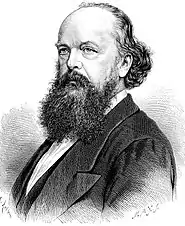Karl Cauer
Karl Ludwig Cauer (14 February 1828, Bonn - 17 April 1885, Bad Kreuznach) was a German sculptor in the Classical style.

(artist and date unknown)

Life and work
His father, Emil Cauer the Elder, was a sculptor. His younger brother, Robert, became one as well. He and his wife, Magdalene (1828-1906) had seven children. Their five sons all became artists: Robert, Hugo (1864–1918), Ludwig and Emil were sculptors; Hans was a painter. His daughter, Maria (1861-1928) married the composer, Arnold Mendelssohn.
He received his initial training in his family's workshop, then left for to Berlin, where he was given further instruction by Christian Daniel Rauch and Albert Wolff. In 1848, he moved to Rome to study antiquities. In 1851, he went to London to examine the Elgin Marbles, and stayed there until 1854; working as a portrait painter. He returned to Germany for three years, then went back to Rome, where he stayed until 1862.
That was the year he was commissioned to create one of his best known works; the monument to Friedrich Schiller in Mannheim. When that was completed, he settled in Bad Kreuznach and worked with his brother Robert at the family studio. After 1873, he divided his time between there and Rome, where he and Robert had another workshop. On behalf of the Prussian Ministry of Education, he was charge of producing casts of antiquities for use at art schools in Berlin.[1] From 1877 to 1878, he was Chairman of the German Art Association there.[2] After 1881, he remained in Bad Kreuznach.
In 1884, he visited the United States to attend the dedication of a monument in St. Louis that he had designed; honoring the assassinated President, James A. Garfield. When he returned, he was severely ill, so a major project, the Hutten Sickingen Monument in Bad Münster am Stein-Ebernburg, had to be completed by his sons Robert and Ludwig. He died early the following year, aged fifty-seven.
He is generally credited with being the inventor of "Elfenbeingips" (ivory gypsum), a molding substance and binding agent which is cheap and easy to clean.[3]
References
- Friedrich Noack: Das Deutschtum in Rom seit dem Ausgang des Mittelalters. Deutsche Verlagsanstalt, Stuttgart 1927, Vol.1, pg. 614
- Friedrich Noack: Das Deutschtum in Rom seit dem Ausgang des Mittelalters. Deutsche Verlagsanstalt, Stuttgart 1927, Vol.2, pg.123
- Klaus Freckmann (Ed.), Angela Nestler-Zapp: Die Bildhauerfamilie Cauer. Künstlerische Gestaltungen und gesellschaftliche Vorgaben, Rheinland-Verlag, Köln 2000, ISBN 3-7927-1824-3, pg.40
Further reading
- Hyacinth Holland: Cauer, Karl Ludwig. In: Deutsche Biographie, 47 (1903), pg.466 f.
- Friedrich Back: "Cauer, Karl". In: Ulrich Thieme (Ed.): Allgemeines Lexikon der Bildenden Künstler von der Antike bis zur Gegenwart. Vol.6: Carlini–Cioci. E. A. Seemann, Leipzig 1912, pg.199 (Online)
External links
- Cauer, Carl Ludwig. Hessische Biografie. In: Landesgeschichtliches Informationssystem Hessen (LAGIS).
- Entry on Karl Cauer @ the Rheinland-Pfälzische Personendatenbank